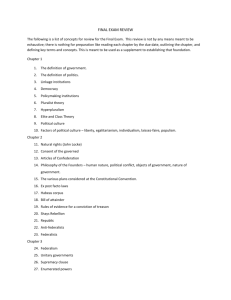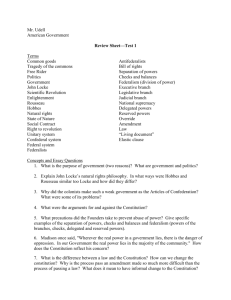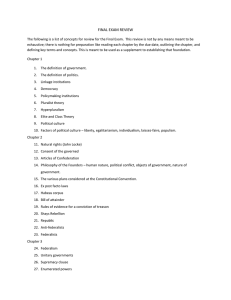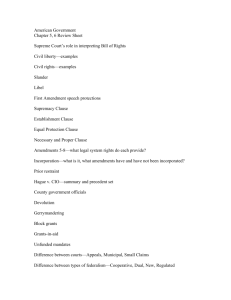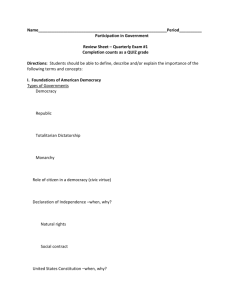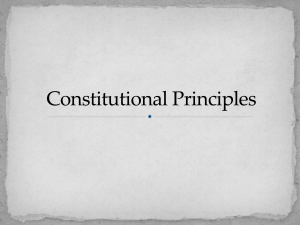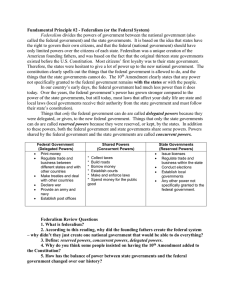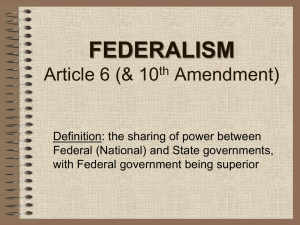Chapter 3 (Federalism)
advertisement
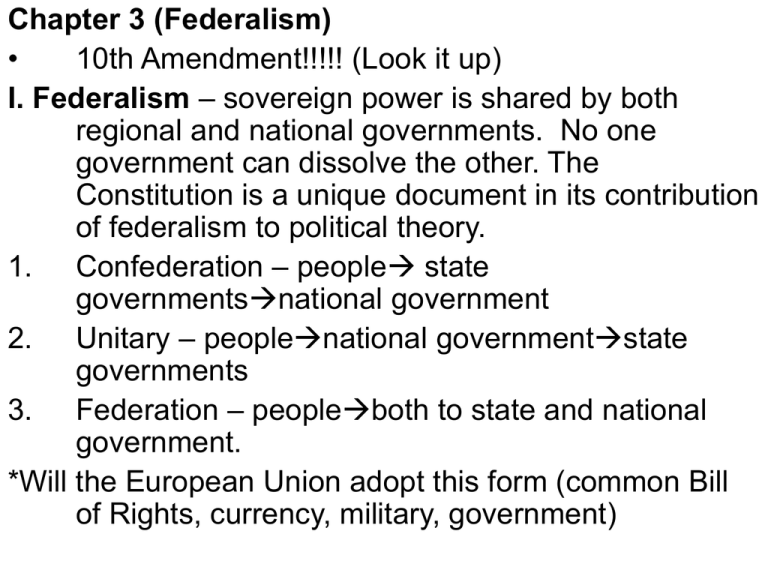
Chapter 3 (Federalism) • 10th Amendment!!!!! (Look it up) I. Federalism – sovereign power is shared by both regional and national governments. No one government can dissolve the other. The Constitution is a unique document in its contribution of federalism to political theory. 1. Confederation – people state governmentsnational government 2. Unitary – peoplenational governmentstate governments 3. Federation – peopleboth to state and national government. *Will the European Union adopt this form (common Bill of Rights, currency, military, government) II. Why Federalism? • Protect Liberty – creates “opposite and rival” centers of power • Dispersing Power – less concentration of power • Increase Participation – more access points for people to participate or contact government • Improve Efficiency – one government can not control it all • Ensuring policy __________________ – people can react to their state policies by moving (i.e., vote with your feet) • Encouraging Policy Innovation – states become “laboratories of democracy” as they experiment with policies/programs observed throughout the country • Managing ___________ – conflicts are less intense since frustrated groups know that policy battles can be settled in many different settings (50 states plus the national government) Drawbacks • slow to move desired policy; takes longer sense there are more veto points along the way • Provides legal basis for state __________________ – South in the 60s in response to Civil Rights legislation and court rulings • Double taxation – state and federal taxes on income III. Design of Federalism A. Delegated/Enumerated/Explicit Powers (the ones written out). National government shall have power to: • Engage in ______ and foreign affairs • Regulate interstate commerce (trade between states) • Regulate the Money supply • tax and spend B. Necessary and _______ Clause (Implied powers) – powers not specifically reserved but inferred from those that are (e.g., the IRS is not in the constitution but it is the means by which Congress exercises its delegated power to tax and spend) C. National Supremacy Clause – Constitution “supreme law of the land” D. Concurrent powers – powers shared by both state and federal government (e.g., tax and spend) E. Powers denied states – coin money, enter into treaties, interfere with the obligation of contracts, levy taxes on imports or exports, or engage in war. F. Powers denied to both state and national government – abridge individual rights G. Reserved Powers – Powers not granted to the national government or specifically ____________ to the states by the constitution are reserved for the states (10th amendment) IV. The Grant as a Source of Federal Power A. Background: In the early 20th century, Congress was finally given the power to tax income. Started very low, but was raised dramatically as a result of two world wars and the Great Depression. When things sort of settled down, the national government decided in the 70s and 80s to send some of the money back to the states in the form of grants. These grants took on three forms: • Categorical Grant: A grant for a specific, narrow project (no spending discretion; ____________) • Block Grant: A grant for a general government function (limited or some spending discretion) • General Revenue Sharing: A grant with generally no strings attached. B. Which form of grant maximizes Congressional power and reduces state power? Answer: categorical



